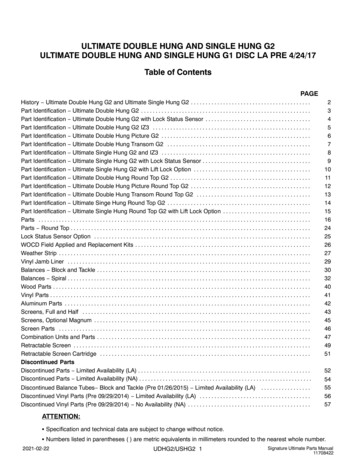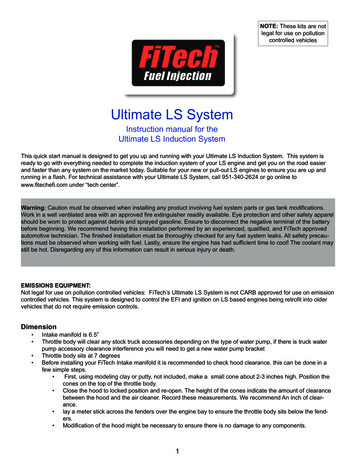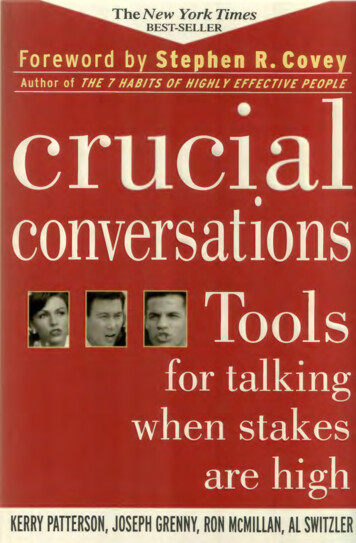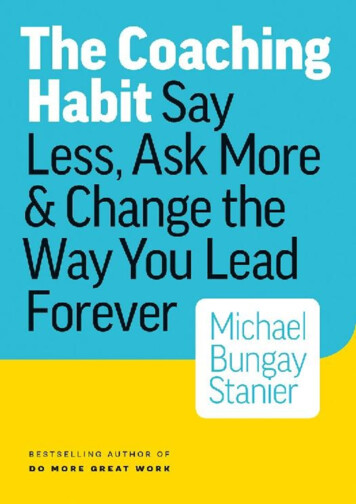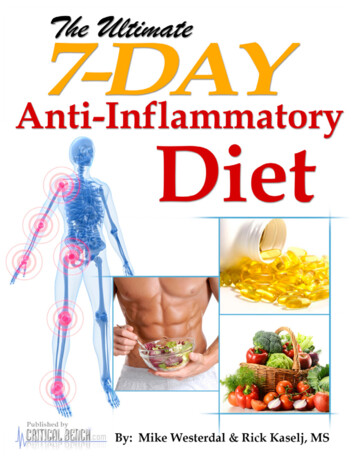
Transcription
The Ultimate:7-DayAnti-InflammatoryDietDiet recommendations, meal plans,shopping lists, supplement tipsBy Mike Westerdal & Rick Kaselj, MSBy Mike Westerdal & Rick Kaselj, MSwww.criticalbench.com 2
Legal Stuff 2013 Critical Bench Inc.All Rights Reserved. International Copyrightwww.CriticalBench.comThis publication is fully copyrighted and does not come with giveaway or resale rights. You maynot sell or redistribute this report. It is reserved solely for paying customers of CriticalBench.com. Copyright and illegal distribution violations will be prosecuted. This document has beenwatermarked with a digital GPS identification tag.NOTICEThe information presented is not intended for the treatment or prevention of disease, nor asubstitute for medical treatment, nor as an alternative to medical advice.This publication is presented for information purposes, to increase the public knowledge ofdevelopments in the field of strength and conditioning. The program outlined herein should notbe adopted without a consultation with your health professional.Use of the information provided is at the sole choice and risk of the reader. You must get yourphysician’s approval before beginning this or any other exercise program.Use of the information provided is at the sole choice and risk of the reader. You must get yourphysician’s approval before beginning this or any other exercise program.By Mike Westerdal & Rick Kaselj, MSwww.criticalbench.com 3
Table of ContentsForeword.5What Is Inflammation?.7The Difference Between ‘Good’ And ‘Bad’ Inflammation. 11How Does Inflammation Affect Your Pain?.14How Inflammation Affects Injury Recovery?.17How Food Can Lead To Inflammation And Pain?.19Foods That Inflame The Body And Increase Pain.21Foods That Help Beat Inflammation.26Hydration And Its Effect On Pain.29Stress And Its Effect On Pain.31Sleep And Its Effect On Pain.34Positive Attitude And Your Pain.38Introduction To Meal Plans .41Meal Plans .43Grocery List .44Bonus Section: Effective Supplements For Pain Relief.45About The Author Rick Kaselj: .50About The Author Mike Westerdal, Hct, Rkc:.52Other Products By Rick Kaselj & Mike Westerdal:.53By Mike Westerdal & Rick Kaselj, MSwww.criticalbench.com 4
Forewordby Chris Wilson, HSC, RKCOn a beautiful Tuesday morning in July, I’mstanding outside an amazing Country Clubin Clearwater, Florida waiting for both MikeWesterdal and Rick Kaselj to arrive. I’veknown Mike for 25 years since our High Schoolfootball days and I’ve been hearing about thisguy Rick from British Columbia for the last5 but never had the opportunity to connectwith him. Mike was always bragging aboutthis “Canadian Guy” that fixed his knee painand fixed his shoulder pain (blah, blah, blah)and now I was going to have the chance tolearn how to fix my back pain? Frankly, hesounded too good to be true.The truck pulls up and out pops this brightlydressed guy with neon sneakers and agrin (mind you he just arrived from B.C. on limited sleep). He gives me a big,“Heyyyyyy” and we walk into the building to get to work. Wow, did we get to work!Over the course of the entire day Rick worked like a machine on and off cameragoing from his Mac to his power-point screen to his Mac with the occasional sip ofcoffee or water. The 8 hours flew by and we made plans to do it all over again thenext day in a different location the gym.Wednesday was even more impressive with filming, speaking, checking notesand that occasional sip. Fast forward another 8 hours and Rick’s still grinning, stillupbeat and still leading the way. Mike and I marveled at his ability to workBy Mike Westerdal & Rick Kaselj, MSwww.criticalbench.com 5
on merely a few hours of rest and put together such tremendous content. Laterthat day it was time for Rick to fly back home and WHOOOSH, he was gone!I head into work Thursday morning and Mike and I just look at each other like,“what just happened?” Rick came to town like an Injury Specialist Whirlwind andwe just went along for the ride. What a ride it was. My takeaway from those fewdays in helping to create Fix My Back Pain was unlike anything I’ve ever beena part of before. I learned so much about the body, what to do when dealing withpain and what to do to avoid pain all together. Mike looks at me and says witha Rick-like grin, “I told you so.”By Mike Westerdal & Rick Kaselj, MSwww.criticalbench.com 6
What is Inflammation?Humans are very fortunate in that our bodies have amazing healing abilities.When an injury occurs, our internal repair mechanisms spring into action to repairthe damage. The body heals itself as part of normal, everyday living without anyspecial effort on our part—it's completely automatic. For the most part, a greatdeal of the healing process takes place without us ever being aware of what'shappening. But other times, we do know that healing is taking place because wesee and feel the symptoms.There generally two importantreasons that we becomeaware of an injury:1) Pain2) InflammationWhen we experienceinflammation, it is a sign thatour body has been injuredand is undergoing a healingprocess. This is becauseInflammation is the body'sattempt at self-protection; the aim being to remove harmful stimuli, includingdamaged cells, irritants, or pathogens - and begin the healing process. The wordinflammation comes from the Latin "inflammo", meaning "I set alight, I ignite".Pull a muscle or tear a ligament and you will know that healing is going on becauseyou'll see and feel it—usually because of inflammation. When an infection or injuryhappens, the body produces a reaction called inflammation, which is characterizedBy Mike Westerdal & Rick Kaselj, MSwww.criticalbench.com 7
by swelling, heat, redness, and pain. Inflammation is the result of the body'simmune system directing healing resources to the site of the injury or infection.The process includes increased blood flow with an influx of white blood cells andother substances that facilitate healing. Without inflammation wounds, injuries andinfections would never heal.The first stage of inflammation is generally referred to as irritation, after which itbecomes inflamed, signaling the immediate start of the healing process. Within afew seconds or minutes after tissue is injured, acute inflammation starts to occur.The damage may be a physical one, or might be caused by an immune response.There are three main processes that occur before and during acute inflammation.First, arterioles, small branches of arteries that lead to capillaries that supply blood tothe damaged region dilate, resulting in increased blood flow. Second, the capillariesbecome more permeable, so fluid and blood proteins can move into interstitialspaces (spaces between tissues). And third, eutrophils and some macrophagesmigrate out of the capillaries and venules and move into interstitial spaces.Venules are small veins that go from a capillary to a vein and neutrophils are atype of granulocyte—white blood cell—that is filled with tiny sacs which containenzymes that digest microorganisms. Macrophages are also a type of white bloodcells that ingests foreign material.There are five signs of acute inflammation, including:1. Pain - the inflamed area will generally be painful, particularly when touched.This is due to the fact that chemicals that stimulate nerve endings arereleased, making the area much more sensitive.2. Redness - this is because the capillaries are filled up with more blood thanusual as blood rushes to injured area.By Mike Westerdal & Rick Kaselj, MSwww.criticalbench.com 8
3. Immobility – due to the injury, the pain or the inflammation, there may besome loss of functionality, flexibility or range of motion.4. Swelling - this is caused by an accumulation of fluid.5. Heat – the flow of blood to the affected area often makes the inflamed areafeel hot to the touch.Inflammation is followed by suppuration (discharging of pus). Afterwards, comesthe granulation stage. Here, within the affected area, the formation of tiny roundedmasses of tissue takes place, facilitating healing. Inflammation is part of a complexbiological response to harmful stimuli. Without inflammation, infections and woundswould never heal.For most of us, inflammation is normallynot a problem—it usually doesn’t last morethan a few days. However, in certain casesinflammation is prolonged and doesn't seemto go away. Prolonged inflammation canlead to chronic inflammation, a condition thatcan result in a progressive shift in the typeof cells present at the site of inflammation.Chronic inflammation is characterized by thesimultaneous destruction and healing of thetissue from the inflammatory process.Of particular concern to bodybuilders, weightlifters or men just trying to get fit, is the factthat chronic inflammation slows down anddisrupts metabolic processes that are criticalto building lean muscle mass and burningBy Mike Westerdal & Rick Kaselj, MSwww.criticalbench.com 9
fat. In particular, chronic inflammation can disrupt the anabolic signals that initiatemuscle growth. In addition, it can also lead to serious health problems, includinga host of diseases such as hay fever, atherosclerosis (clogged arteries), orrheumatoid arthritis. Some experts say that chronic inflammation can also increaseyour risk of contracting certain types of cancer.In a small percentage of cases chronic inflammation is the result of a legitimatemedical condition that must be treated by a medical professional. However, for themajority of men, the onset of chronic inflammation can be linked to one particularcause--an unhealthy lifestyle. By this I mean poor diet, lack of stress managementskills, not getting enough sleep, smoking, excessive drinking or insufficientexercise. All of these can diminish our bodies' ability to manage inflammation.By Mike Westerdal & Rick Kaselj, MSwww.criticalbench.com 10
The Difference Between‘Good’ And ‘Bad’InflammationIn developing an overall understanding of inflammation and its impact on ourbodies and metabolic systems, it is important to know that not all inflammation isbad. In fact, some inflammation is actually very good for our bodies while othertypes of inflammation are not.Although we generally associate inflammation with pain, we need to understandthat the inflammation is a necessary element in the body’s healing response to aninjury (or infection). The inflammation and associated pain tell us two importantthings:1) We have an injury or wounded area that must be pampered in order to heal.2) The healing process is underway as it should be. By the way, the pain that isassociated with inflammation is the result of inflamed tissue pressing up againstnerve endings, along with chemical substances that convert molecular signals intoelectrical impulses that trigger the pain sensation.In its role as a facilitator of the healing process, inflammation is generally either in‘attack’ mode or ‘heal’ mode. In the attack mode, inflammation recruits the immunesystem to protect the body from an injury and to mitigate infection. In the healmode, inflammation works to re-grow damaged tissue as it facilitates the healingprocess.With this knowledge in mind, it is easier to understand the difference betweenBy Mike Westerdal & Rick Kaselj, MSwww.criticalbench.com 11
‘good’ and ‘bad’ inflammation. Acute inflammation—which occurs immediatelyafter an injury and is almost always short-lived—would be considered ‘good’inflammation. In contrast, chronic inflammation—which is an unhealthyinflammatory over-response is ‘bad’ inflammation because it can linger for weeks,month or even years. In addition, chronic inflammation can be linked to a numberof dangerous diseases. In fact, a growing number of experts believe that chronicinflammation may very well be the underlying root cause of a multitude of diseasesand life-threatening health conditions.Systemic inflammationis also considered badinflammation. Systemicinflammation is generallythought to be caused by amassive release of cytokinesthat spreads throughout theentire body. Left unchecked,systemic inflammation canresult in organ failure andeven death in some cases.Inflammation Can Causethe Following Diseases &Health Hazards Athsma Irritable Bowel Syndrome Allergies Skin Disordes Heart Disease Arthritis Congestive Heart Failure Arterial Diseases Obesity & Weight GainTumor FormationCancerType 2 DiabetesAlzheimer'sNow that we know the difference between acute (good) inflammation and chronic(bad) inflammation, the next step is to understand some of the causes of chronicinflammation and the steps we can take to prevent it. Environmental variables suchas stress, smoking, certain chemicals or substances and certain foods have allbeen shown to support the onset of chronic inflammation. These are all factors wecan—for the most part—reduce or eliminate from our lives (e.g., learn to managestress, don’t smoke, reduce exposure to harmful chemicals, etc.). And of these,diet is the single most important controllable factor in regards to whether or not anindividual experiences chronic inflammation.By Mike Westerdal & Rick Kaselj, MSwww.criticalbench.com 12
Food is the most important element because this is of course how our bodiesobtain the nutrients necessary to support life. Food also sets the stage for thefunctioning of the body’s metabolic systems. Healthy diets support healthymetabolic system functioning and likewise, unhealthy diets result in unhealthymetabolic system functioning—and the onset of illness, disease and conditionssuch as chronic inflammation.Later in this report I’ll tell youexactly which foods can triggerthe onset of inflammation andwhich foods can keep yourmetabolic systems in top shapeand your body free of chronicinflammation.By Mike Westerdal & Rick Kaselj, MSwww.criticalbench.com 13
How Does InflammationAffect Your Pain?As discussed in the previous section, afteran injury, there is a three-step processthat occurs:1) The flow of blood to the affected areaincreases.2) The small blood vessels in the affectedarea become more permeable, whichallows large molecules to leave thebloodstream and reach the infection.3) There is an increased migration ofphagocytes toward the site of infection.Phagocytes are white blood cells thatprotect us by ingesting harmful foreignparticles, bacteria and even dead or dyingcells. All this action going on causes theaffected area to look red, swell up andfeel hot and painful—in other words, tobecome inflamed.Pain is one of the most notable features of inflammation. The pain that we feel isa signal that the body has been injured or that something is otherwise wrong. Interms of our evolution, pain evolved as a signal to tell us to stop what we weredoing or to take alternative action. It is essentially a defense mechanism that alertsBy Mike Westerdal & Rick Kaselj, MSwww.criticalbench.com 14
us to an injury, thus allowing us to protect our bodies and not damage our bodiesany further than what we already have.Because of the potential danger involved with pain—literally life or death—thepain signal had to be strong and nearly impossible to ignore. Otherwise, we mightnot stop or avoid the pain-causing danger. The pain signal is closely linked to thefight or flight response, wherein our bodies go into alarm mode. In this state ourmuscles receive more blood flow and oxygen, our heart beats faster, our breathingquickens and we get ready to stand and fight or run from danger. In short, the painresponse is an extremely efficient way to motivate us to respond quickly to threats.When we experience inflammation, the affected area often hurts and may be stiff.The pain can result in an overall feeling of discomfort, distress and even worse,depending on the severity of the inflammation. The inflammation-related pain can beconstant and steady, in which case it is often referred to as an ache. Alternatively, thepain can be of a throbbing type, a pulsating pain, or it can be a stabbing or pinchingpain. In any case, pain is either acute (short-term, intense) or chronic.In addition, pain can also be: Nociceptive pain: This type of pain is caused when special nerve endings—called nociceptors—become irritated. Nociceptive pain is the type of pain youfeel when you burn yourself, twist your ankle, or stub your toe, all of whichcan result in inflammation. This type of pain is felt as a dull or sharp achingpain, and it can be mild to severe. Nociceptive pain can be either acute (e.g.,sprained ankle) or chronic. Nociceptive pain usually responds well to painmedications, anti-inflammatory agents, or other drug therapies. Somatic pain: Somatic pain is a kind of nociceptive pain that is felt inmuscles, joints, bones, ligaments, and on the skin. Musculo-skeletal pain issomatic pain. When you cut your skin, the pain you experience is somaticBy Mike Westerdal & Rick Kaselj, MSwww.criticalbench.com 15
pain. You also experience somatic pain if you stretch a muscle too far orexercise for a long period of time. In these cases, nociceptors send impulsesto the brain when they detect some kind of tissue damage. Somatic paintends to be sharp and localized - touching or moving the affected area willresult in more severe main. Visceral pain: This is also a type of nociceptive pain. With visceral pain, thepain is sensed deep down in the body, in the internal organs and main bodycavities, such as the heart, lungs, bowels, spleen, liver, kidneys, bladder,uterus, and ovaries. The pain is usually described as a deep ache. Crampingand colicky sensations are examples of visceral pain.In all of the types of pain above, inflammation primarily causes pain because theswelling pushes against the sensitive nerve endings, which send pain signals to thebrain. Nerve endings send pain signals to the brain all day long; however, it learnsto ignore most of them, unless pressure against the nerve endings increases.By Mike Westerdal & Rick Kaselj, MSwww.criticalbench.com 16
How Inflammation AffectsInjury Recovery?Wound healing takes place through a series of four precisely and highlyprogrammed phases: hemostasis, inflammation, proliferation, and remodeling.In order for a wound to heal successfully, all four phases must occur in the propersequence and time frame. Many factors can interfere with one or more phases ofthis process, thus causing improper or impaired wound healing. When a woundexhibits impaired healing it is generally because it has failed to progress throughthe normal stages of healing. These ‘impaired healing’ wounds most often enter astate of pathologic inflammation due to a postponed, incomplete, or uncoordinatedhealing process. This type of situation inhibits injury recovery.A ‘wound’ can be something external such as a cut on the skin or it could be aninternal injury such as a sprain or torn ligament. Also, the muscle soreness andjoint pain the people often experience after strenuous workouts are more than justa nuisance—they’re actually symptoms of post-workout tissue inflammation, whichslows recovery, limits fitness gains and even causes overuse injuries.On the plus side, when we experience an obvious injury (e.g., twisted ankle, tornligament, etc.), inflammation helps heal the affected area and also producessymptoms of pain and stiffness that discourage activity during the healing process—thereby further supporting the recovery process. During normal workouts when wedon’t suffer any particular injury, a much tamer inflammation response occurs.The truth is that nearly every workout causes some degree of microscopic damageto muscle fibers. The body’s inflammation response repairs this damage during thefollowing recovery period, which begins about two hours after a workout and lastsfor up to 48 hours, depending onBy Mike Westerdal & Rick Kaselj, MSwww.criticalbench.com 17
Besides facilitating the repair of everyday muscle damage resulting from strengthtraining and exercise, inflammation promotes training adaptations such as satellitecell proliferation. This is an essential step in the development of bigger, strongermuscle fibers. Inflammation even makes our muscles more resistant to futuredamage by strengthening particular areas. The inflammation response essentiallyhelps protect the muscle fibers from future damage—at least to a degree.But there is of course a negative aspect to inflammation as well. Althoughinflammation does indeed repair tissue damage resulting from exercise, it can alsocause further damage—secondary muscle damage—between workout sessions.Secondary muscle damage is the main reason you feel more pain and stiffness theday after an especially strenuous workout than you do when you leave the gym.This phenomenon is referred to as delayed-onset muscle soreness (DOMS), whichis a symptom of muscle tissue damage (inflammation).Additionally, joint tissues also suffer damage during strenuous exercise andundergo a subsequent inflammation response. When joint tissues fail to regeneratefully between workouts, they may become chronically inflamed and/or degenerateto the point of serious injury. This can lead to the development of overusesyndrome.Factors that promote healing and injury recovery (reduced inflammation) YouthGood nutrition protein, vitamins A and CAdequate hemoglobin to transport nutrients and oxygenStaying properly hydratedProper exercise and weight training regimens such as incrementallyincreasing weight or resistance (no big leaps in weight), using proper formand getting plenty of rest in between workout sessions.By Mike Westerdal & Rick Kaselj, MSwww.criticalbench.com 18
How Food Can Lead toInflammation and Pain?Food and water are the essence oflife—without them our bodies couldnot function and we would die. Foodin particular, provides the necessaryprotein, carbohydrates, fats, nutrients,vitamins and minerals we need tofunction and maintain our metabolicsystems in top form. Eat a healthy dietand the body functions well—eat a poordiet and the metabolic systems arethrown off balance, and do not functionproperly. When this occurs, in additionto loss of energy and weight gain, ourbodies become susceptible to illness,disease, injury, inflammation and pain.A proper, healthy diet is one that is richin lean proteins, complex carbohydratesand healthy fats. The body gets its fuelto facilitate the recovery process fromthe foods we eat. That’s why it’s especially important for bodybuilders and exerciseenthusiasts to focus on eating lean proteins, complex carbohydrates and healthyfats. It is from these that the body manufactures the tools of recovery.In a perfect world, we would get 100% the substances we need to recover fromthe foods we eat. But in today’s modern world that’s not always possible. ModernBy Mike Westerdal & Rick Kaselj, MSwww.criticalbench.com 19
technologies and processes allow us to have convenient access to food thatwasn’t possible a couple generations ago, but along the way, a good portion ofthe nutritional content gets lost. That’s where nutritional supplements come intothe picture. In addition to eating healthy, taking supplements can help ensure thatour muscles have ready access to everything they need for the recovery process,which ultimately results in less inflammation.Conversely, a poor diet can lead to both inflammation and pain. In 2006, theUniversity of Naples conducted a study on the impact of diet on inflammation. Thestudy showed that dietary patterns high in refined starches, sugar, and saturatedand trans-fatty acids, poor in natural antioxidants and fiber from fruits, vegetables,and whole grains, and poor in omega-3 fatty acids may cause an activation of theinnate immune system. Researchers determined that this is most likely caused byan excessive production of pro-inflammatory cytokines associated with a reducedproduction of anti-inflammatory cytokines. The study determined that the whole dietapproach is particularly promising to reduce the inflammation associated with themetabolic syndrome.By Mike Westerdal & Rick Kaselj, MSwww.criticalbench.com 20
Foods that Inflame theBody and Increase PainWe know that inflammation is swellingthat occurs as the body’s self-protectionmechanism tries to remove harmfulstimuli such as damaged cells or irritants.The body’s approximately 230 joints areparticularly susceptible to inflammation.And when joint inflammation occurs,it inhibits mobility and causes pain. Insome cases joint inflammation can resultin severe pain that can last for days,weeks or longer, sometimes becoming achronic condition that lasts a lifetime. Ineither case, joint inflammation can reallyinhibit or even bring to a halt weight andstrength training.In an effort to uncover the reasonswhy some people seem to be moresusceptible to inflammation than others,researchers discovered a link between diet and occurrences of painful suddenor chronic joint inflammation. Their studies showed that people who at certainfoods—or types of foods—had few instances of joint inflammation and when it didoccur, these people recovered at a faster rate than others, who did not eat thesefoods.Even more interesting is the fact that they discovered that people who at a differentBy Mike Westerdal & Rick Kaselj, MSwww.criticalbench.com 21
type of food—or types of foods—were more likely to be plagued by either suddenor chronic joint inflammation. Not surprisingly, it also took these individuals muchmore time to recover from joint inflammation than those who belonged to the othergroup.And there’s good reason to be concerned about joint inflammation—particularlychronic inflammation—and it’s not just the painful joints, muscles, swelling and lossof mobility. In fact, chronic joint inflammation can increase your risk of developingserious and potentially deadly diseases and conditions including diabetes, heartdisease, Alzheimer’s disease and certain types of cancer. Other factors such asgenetics, overall health, lifestyle, amount of sleep and more play a role as well, butnevertheless, chronic joint inflammation can be a significant contributing factor.Because it is how our bodies obtain the nutrients they need to thrive and behealthy, diet can be linked to an increased likelihood of developing any of theconditions or diseases above. But diet isn’t the only common thread here—chronicjoint inflammation can actually be viewed as a ‘precursor’ to these other conditionssuch as diabetes, heart disease and the others. That does not necessarily meanthat every person with chronic joint inflammation will develop these other illnessesor conditions, but it does increase the chances.Unfortunately, outward symptoms of joint inflammation can take years and yearsto develop, meaning that many people are not even aware of the fact that theirjoints are inflamed until it becomes painful and inhibits mobility. Luckily though,measuring C-reactive protein (CRP) levels in the bloodstream can help tell you thedegree to which you are on the path towards developing chronic joint inflammation.Researchers have discovered a link between increased CRP levels in thebloodstream and systemic joint inflammation. Even more important, they now knowthat there is a correlation between diet and CRP levels. People whose diets includehealthy fats, complex carbohydrates, lean proteins and antioxidant-rich foodsBy Mike Westerdal & Rick Kaselj, MSwww.criticalbench.com 22
showed lower levels of CRP than persons with diets that mostly consist of highlyprocessed foods, refined sugars, trans fats and simple carbs.Here are foods to avoid for the next seven days (and beyond), if you want toreduce the probability that you will develop systemic joint inflammation:1. Sugars—especially ones that are refined such as those found in candies,sodas, condiments and other common foods2. Wheat—(gluten) because a growingnumber of people are becominggluten sensitive, which simulates anallergic response3. Dairy and milk products—likegluten, more and more people aredeveloping lactose intolerance, whichupsets the body’s natural metabolicbalance. Additionally, the majority of commercial dairy products come fromcows that have been exposed to a lifetime of antibiotics, growth hormonesand worse4. Processed foods—of any type because processing usually means thatthe natural beneficial nutrients have been taken away and other, artificialingredients added to take their place5. Fast foods—these are usually very high in unhealthy, saturated and transfats, sodium and sugar6. White bread—which is ‘white’ because many of the he
In fact, some inflammation is actually very good for our bodies while other types of inflammation are not. Although we generally associate inflammation with pain, we need to understand that the inflammation is a necessary element in the body’s healing response to an injury (or infection). The inflam


